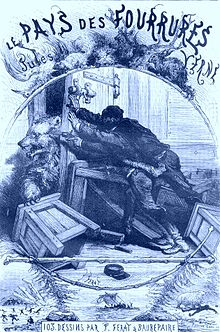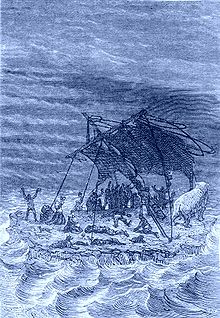The land of fur

The land of furs , also: On outposts in the land of furs ( French Le Pays des fourrures ) is a novel by the French author Jules Verne . The original edition was published by Pierre-Jules Hetzel in Paris in 1873 . The German-language edition appeared in 1875 under the title Das Land der Furze . The English title of the novel is The Fur Country .
action
Soldiers, Indian chiefs, and explorers like Paulina Barnett and their servant Madge meet at a Hudson's Bay Company reception in Fort Reliance. Paulina Barnett has already traveled the Brahmaputra to Tibet and white spots on the map of Australia such as the Gulf of Carpentaria in the past . This time she is planning a trip to the far north of Canada . She wants to join the expedition of Lieutenant Jasper Hobson, who wants to advance across the Arctic Circle into arctic regions. The Hudson Bay Fur Company commissioned him to set up a new branch for trading in fur on the north coast of the American continent. This happens against the background of the planned sale of Alaska by Russia to the USA . The new base should enable a trade connection across the Pacific with steamers as an alternative to the Northwest Passage , which was assumed at the time . The expedition is also joined by the astronomer Thomas Black, who wants to observe the total solar eclipse on July 18, 1860 in the far north. He plans to detect the sun's corona , which is only visible when the moon moves in front of the sun. A total of 19 people set off north with 12 dog sleds. Over the Great Bear Lake in the Northwest Territories, they finally reach the 70th parallel at Cape Bathurst at the time of the midnight sun and build their Fort Esperance on the Victoria Peninsula. There they hunt fur animals such as badgers, lynxes, beavers, muskrats, martens, weasels and silver foxes. To their amazement, the tides are low . Ebb and flow can hardly be observed. A child is born among the settlers. They overwinter in the cold polar night . The temperatures reach values of down to −52 ° C. You survive the attack by polar bears and are visited by an Eskimo family. The girl Kalumah befriends Paulina Barnett and promises to visit her again. In the polar night they suddenly see the glow of fire on the horizon. A volcano has erupted. The volcanic eruption offers a tremendous spectacle and leads to an earthquake. Lieutenant Hobson waits in vain for the announced replacement force with new equipment such as ammunition, liquor and medicines. You see that there are no more tides. The solar eclipse finally occurred on July 18, 1860. However, this is not total, but only partial. Thomas Black is furious because this prevents him from observing the sun's corona and the next total solar eclipse north of the Arctic Circle will not occur again until August 9, 1896. The astronomer then makes a new position determination. They discover that their position has changed, and it soon becomes clear that the peninsula is actually a forested ice floe that broke away from the mainland during the earthquake and is now drifting rudderlessly through the polar sea. At first they leave the soldiers in the dark so as not to undermine the morale of the troops. On the one hand you are building a small sailing ship and on the other hand you are planning an outbreak over the frozen sea in the coming winter. As the ice floe drifts near the North American mainland again, Kalumah kayaks onto the drifting ice floe to keep her promise. Hobson finally informs the soldiers of their situation. In the polar winter they try to break out over the frozen sea. However, this fails because of the piled up pack ice and rift breaks in the ice cover and they have to turn back. Fort Esperance is later buried by a collapsing wall of ice. Kalumah, Paulina Barnett, Madge and Thomas Black can be rescued from the buried house by the others. However, the sailing ship is lost. Instead, the settlers build a raft. The former peninsula is slowly drifting south into warmer waters and is gradually melting. Ice sheets break off again and again. In the end, the raft is also lost. A whaler passes the floating ice floe, but does not notice the settlers. They can accelerate their journey with sails. They are finally driven with the heavily melted ice floe on the island of Blejinic in the Aleutian Islands and finally rescued by the fishermen there.
literature
- Heinrich Pleticha (ed.): Jules Verne manual . Deutscher Bücherbund / Bertelsmann, Stuttgart and Munich 1992.
- Volker Dehs and Ralf Junkerjürgen: Jules Verne . Voices and interpretations of his work. Fantastic Library Wetzlar, Wetzlar 2005.
- Volker Dehs: Jules Verne . Jules Verne. A critical biography. Artemis & Winkler, Düsseldorf 2005. ISBN 3-538-07208-6
Web links
- "The Land of Furs" as an e-book in HTML on zeno.org
- The land of furs in Andreas Fehrmann's Jules Verne Collection
